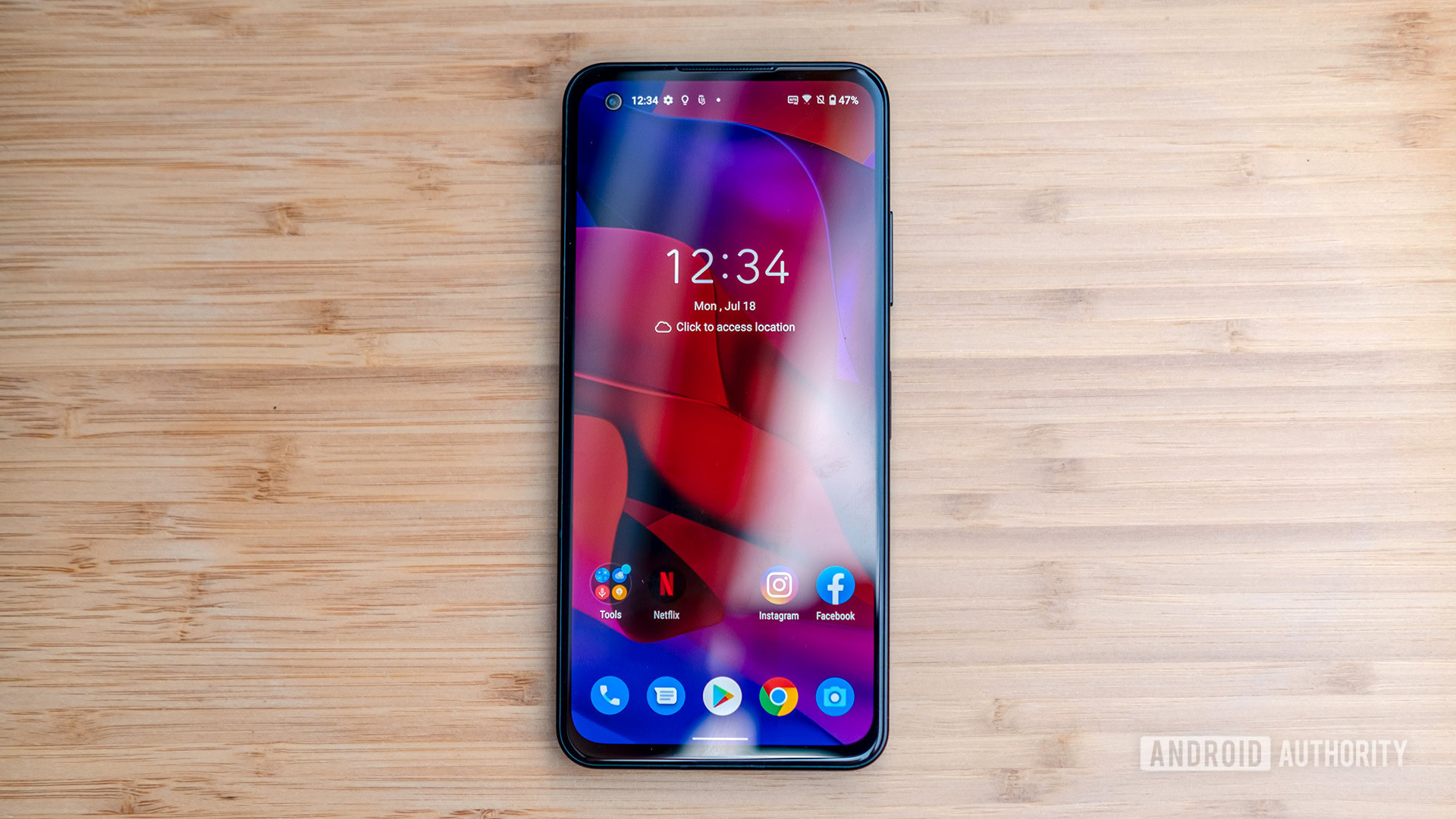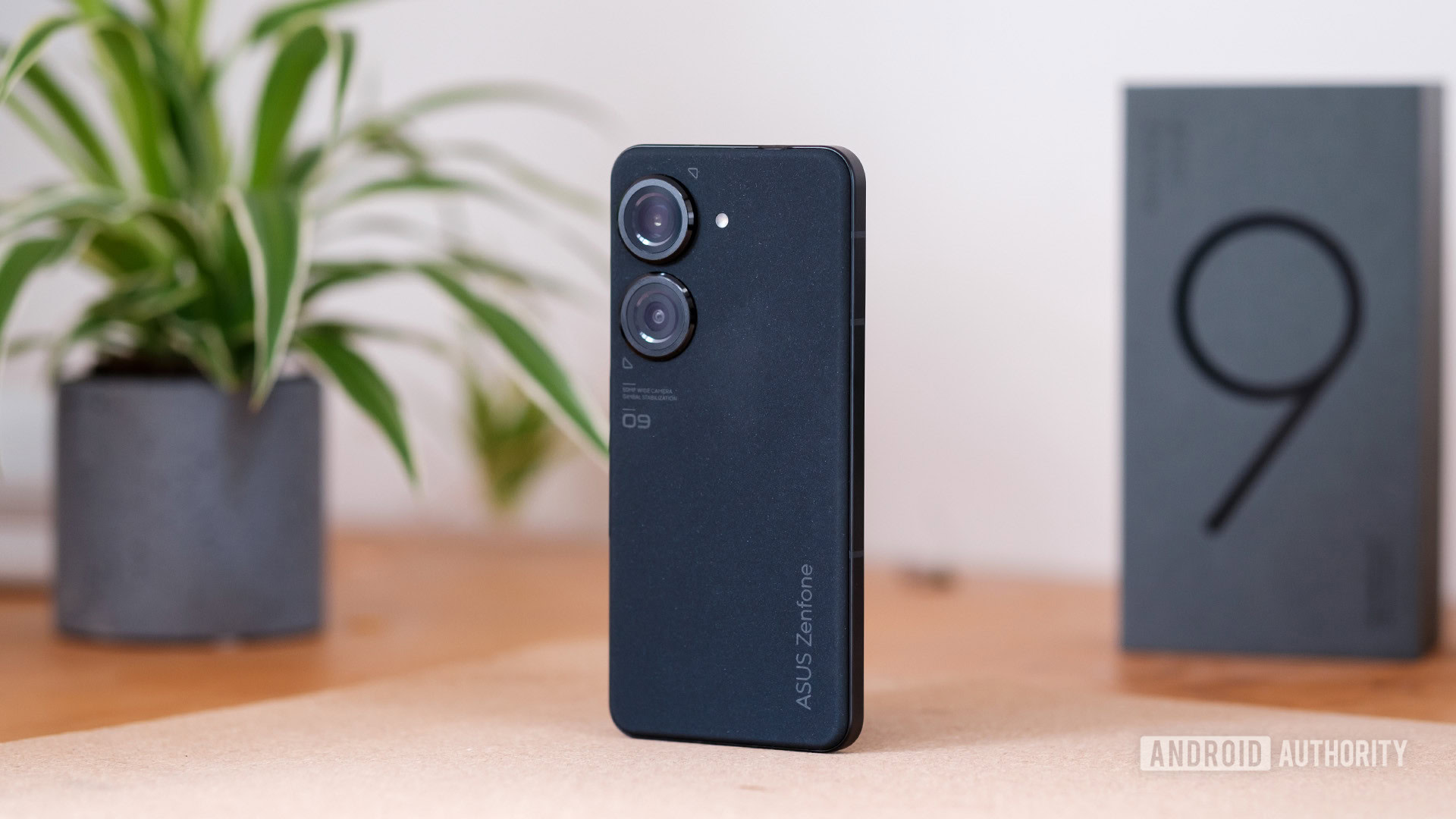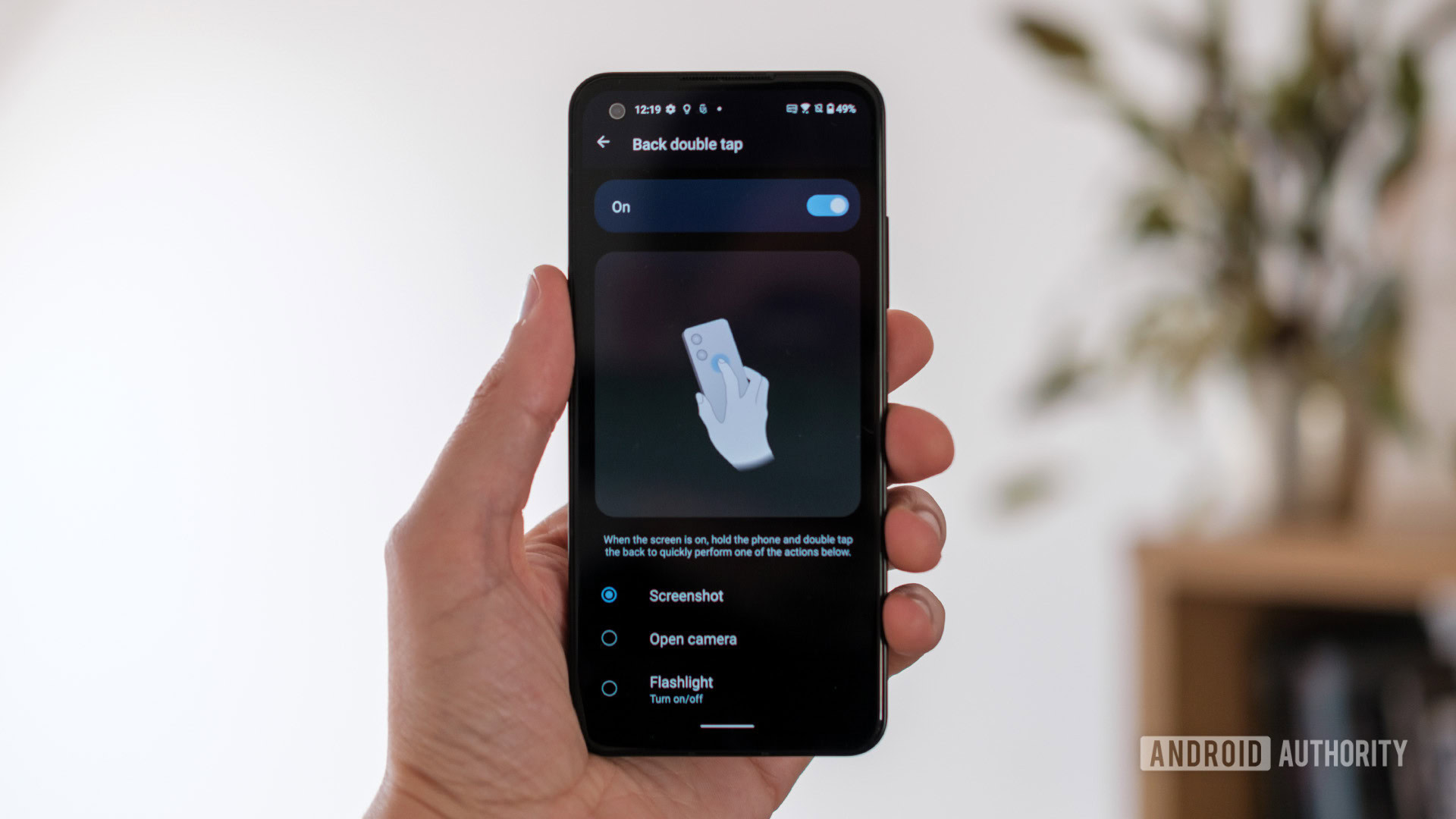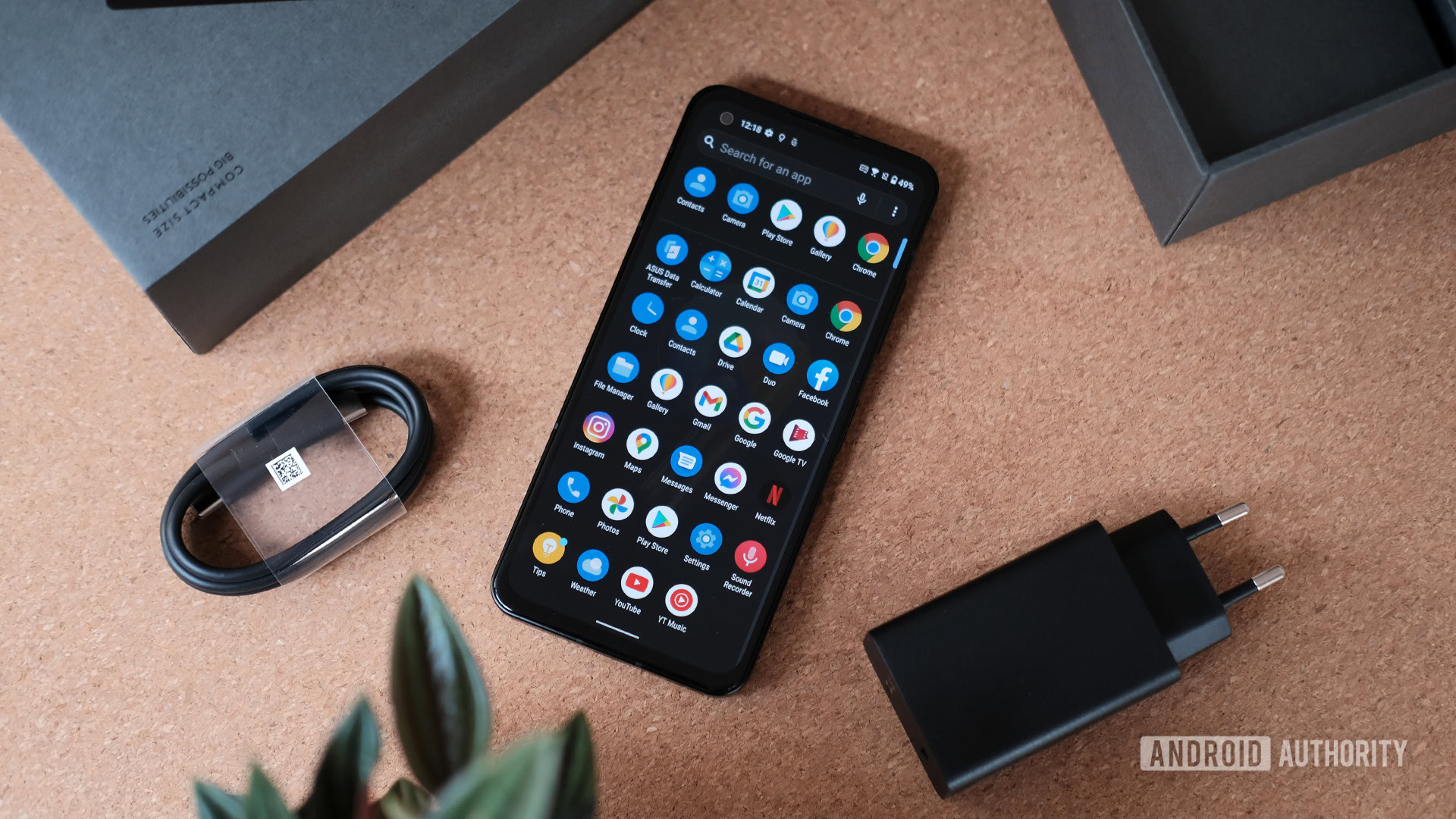Affiliate links on Android Authority may earn us a commission. Learn more.

ASUS Zenfone 9 review: Small in stature, big on personality
Published onJuly 3, 2023
Asus Zenfone 9
What we like
What we don't like
Asus Zenfone 9
ASUS continues its previous generation’s compact form-factor flagship with the Zenfone 9. Historically, smaller phones have compromised on features and performance, but that’s not the case here. At least not entirely. ASUS attempts to distill a full-fledged affordable flagship experience into one of the smaller form factors on the market. With its small size but plenty of power, can ASUS’ handset earn a home in your pocket? Find out in our ASUS Zenfone 9 review.
Update, July 2023: This review has been updated with information on the new ASUS Zenfone 10.
What you need to know about the ASUS Zenfone 9

- ASUS Zenfone 9 (8GB/128GB): $699 / €799
- ASUS Zenfone 9 (8GB/256GB): $749 / €849
- ASUS Zenfone 9 (16GB/256GB): $799 / €899
With a comparatively small 5.9-inch display and trim 169g weight, the ASUS Zenfone 9 is about the same size as the Samsung Galaxy S23, albeit a little thicker. ASUS notes a 10% larger SoC, 40% bigger camera system, and 7.5% battery capacity increase, all in a form factor smaller than 2021’s Zenfone 8.
The phone sports the same 5.9-inch panel as last year, but ASUS made a few optimizations to improve the display’s color accuracy. It supports refresh rates up to 120Hz and can automatically switch between 60, 90, and 120Hz modes depending on the app or content being viewed. But it’s not an LTPO panel capable of the ultra-low power-saving refresh rates seen on other flagships.
Other staples from the previous generation stick around too, including an IP68 rating against water and dust resistance, a 3.5mm headphone jack, and 30W wired charging via USB Power Delivery PPS or Quick Charge 4.0 and above. ASUS bundles a charger in the box, instead making eco-conscious decisions in the form of recycled packaging. At 30W, the phone takes 11 minutes to reach 25% capacity, 37 minutes to 50%, and just under an hour and a half to full, which is pretty basic stuff for a flagship.
The phone packs several other improvements, though. There’s now a six-axis gimbal-stabilized and bigger primary camera sensor, Dirac-tuned linear speakers that offer great sound and stereo balance (even though only the top one is front facing), Snapdragon Sound with aptX Lossless Bluetooth audio, and Qualcomm’s powerful and efficient Snapdragon 8 Plus Gen 1 processor. ASUS also debuts hardware-based gestures as part of its fingerprint scanner button and Back Double Tap feature. For this review, we were sent the top-end variant to test (16GB RAM/256GB storage).
The ASUS Zenfone 9 is available in Midnight Black, Moonlight White, Starry Blue, and Sunset Red colorways, depending on your region. The phone went on sale in Europe first, starting at €799. Pre-orders for US buyers opened on September 2, 2022 at $699 via Amazon, with general sales commencing in October. The handset is also available in Hong Kong, Taiwan, Japan, Indonesia, and parts of South America.
The Zenfone 9 was superseded by the Zenfone 10 which launched in June 2023 with an upgraded processor, wireless charging, and enhanced software gestures.
What’s good?

Recent Zenfone models have prioritized ergonomic design, and the Zenfone 9 is no exception. Weighing just 169g and boasting a compact 5.9-inch display, the handset is built to actually fit in your pocket. That’s a welcome change of pace from the behemoths that roam the flagship market. The phone aims to ensure that everything is within a thumb’s reach. It’s well built too. The rectangular edges ensure the small phone feels robust in hand, there’s a nice feel to the back’s polymer material, and Gorilla Glass Victus protection on the front provides peace of mind from drops.
Finally, a phone that actually fits in your pocket.
Powered by Qualcomm’s revamped, energy-efficient Snapdragon 8 Plus Gen 1, performance is as snappy as you’d expect. The Zenfone 9 breezes through multi-tasking and will run high-performance games at high frame rates, thanks to a vapor chamber cooling system that helps make up for the phone’s small stature. Apex Legends hovers mostly close to 60fps, although Genshin Impact struggles through longer sessions with the graphics maxed out. If you’re really into gaming, the same Game Genie overlay found in the ASUS ROG Phone 6 and newer ROG Phone 7 allows you to control notifications, performance, and other settings mid-play. However, the phone is a bit too small for serious gaming sessions in terms of both screen size and sustainable performance (more on this later).
As you can see in the graph above, this is one of the best-performing phones of 2022, at least where Geekbench 5 and 3DMark are concerned. However, the mixed-workload PCMark test hands in a result closer to the Tensor-powered Pixel 6 series. That’s still fine but highlights the use of more conservative clock speeds when running in the “Dynamic” performance setting, which balances performance against battery life. Thankfully, this doesn’t impact the responsiveness of web browsing, messaging, etc., but is something to consider for those with a demanding workload. ASUS provides a high-performance mode, should you want to run the phone flat out for longer periods, but this pumps out too much heat for my liking and chugs down the battery.
That said, battery life is generally very decent, particularly for a phone of this size. The 4,300mAh cell generally handled over five hours of intense gaming and around eight or so hours of screen time with average usage during our testing. That’s enough to take most users through a day of lighter workloads with a little charge to spare.
At first glance, Zen UI offers a lightweight, stock-like appearance. Out of the box, there’s Android 12‘s familiar Material You theming, icons, and the standardized settings menu that you’ll find on Google’s Pixel series. That said, ASUS imbues its software with a high degree of customization in the audio and display departments.
Further customization comes via Back Double Tap on the back, the Zentouch/smart key/fingerprint scanner, and on-screen letter gestures, which can be mapped to various functions or to launch your favorite apps. This is where the phone comes into its own. The fingerprint scanner offers fully mappable press and hold, double press, and swipe actions. The Back Double Tap gesture is limited to screenshots, opening the camera, flashlight toggle, sound recorder, launching Google Assistant, or playing/pausing music and video. There’s even more room to access your favorite apps through ASUS’ Edge Tool home screen edge-swipe feature; if anything, there’s a little too much to dive into here. The bottom line: the Zenfone 9 really wants you to make the phone your own.
Customizable tap and swipe gestures give the Zenfone 9 a unique personality.
Since its launch, ASUS has updated the Zenfone 9 to Android 13. The update includes cross-device copy and paste, new notification permission, per-app language settings, and several other new Android features. There’s also a new classic quick setting UI toggle, but otherwise the core Zen UI experience remains virtually the same after the update.
Finally, the fingerprint scanner, located in the smart key power button, is wonderfully swift and easy to calibrate during setup. It’s far faster and more accurate than most in-display variants that occasionally sacrifice functionality at the altar of voguishness. It’s only a small aspect of the phone’s already pint-sized design, but the smart key addition lends the phone a unique identity and
What’s not so good?

ASUS’ design may offer superb ergonomics, but other elements are more hit-and-miss. The large camera housing and accompanying text, seemingly inspired by ASUS’ ROG gaming series, won’t be to everyone’s taste. Similarly, while nice feeling, the high-grip polymer material on the rear isn’t as anti-fingerprint as ASUS makes out. It retains smudges and marks that are easier to remove on glass — at least on the black model I’ve reviewed, which is also a bit uninspiring overall. Still, the new design is a significant step up over the basic budget look of last year’s Zenfone 8.
As much as we praised the phone’s performance in the previous section, sustaining this is a whole other issue. The phone becomes hot during protracted gaming sessions, especially when running high-performance mode, when it’s just too hot to handle. However, this is more down to the handset’s small size rather than an obvious chip issue. There’s only so much heat the tiny phone can dissipate, so it can’t quite make the most of the 8 Plus Gen 1 chip’s full potential for long. That said, the phone performs marginally better over several tests than larger 8 Gen 1 phones we’ve tested, thanks in part to the more efficient Plus chip variant.
There’s no wireless charging here, an omission at this price, even on a smaller handset. ASUS doesn’t offer a microSD card slot either. That’s not uncommon for modern flagships, but it would be unhelpful given the internal storage capacity option maxes out at 256GB. It also doesn’t support mmWave 5G for US customers with access to ultra-fast networks, instead opting for exclusively sub-6GHz 5G in all regions.
No wireless charging and just two years of support don't help make ASUS' case.
Overall, the Zenfone 9 is missing just a few staple features you’ll find with other affordable flagship handsets, but the real kicker is the limited software update pledge. Two OS upgrades and “at least” two years of security patches are poor for a $699 phone. At launch, it’s two closest Android rivals — the Google Pixel 6 and Samsung Galaxy S22 — saw see five years of security updates each, making them superior long-term purchases. Other brands have caught up in the interim as well. I could also do without the pre-installed Facebook, Instagram, and Netflix apps, though they can thankfully be uninstalled.
ASUS Zenfone 9 camera review

The Zenfone 9’s dual camera package has seen a couple of noteworthy updates this generation. The Sony IMX766 primary sensor is not only larger than last year’s sensor but supports six-axis gimbal image stabilization or video and low-light shots. That said, the selfie and ultrawide cameras remain unchanged from the Zenfone 8. Can it compete with the very best camera phones?
The new sensor produces vibrant shots with a solid white balance and robust autofocus. HDR capabilities meet expectations when using the main and ultrawide cameras, delivering well-balanced highlights and shadows without overblowing the colors. As a quick shooter, there’s nothing glaringly wrong with the main camera. That said, colors and exposure can be inconsistent, varying from oversaturated to washed out and occasionally too dark. There’s also a noticeable amount of oversharpening on textured surfaces and a noisy-looking natural bokeh in a lot of the pictures I took — a consistent issue with the IMX766 in my experience. Most images are fine for social media, but many don’t hold up so well on a larger screen or print.
The larger sensor helps out in low-light situations. Paired with ASUS’ automatic night mode and six-axis stabilization, you’ll obtain decent exposure even in dimly lit environments, but colors can be washed out when using night mode in very dark lighting. The excellent stabilization ensures that long exposures remain mostly blur-free, but this solid feature is crying out for an even bigger sensor, better lens, and improved processing to really help the camera shine.
The ultrawide camera provides a 113-degree field of view. That’s far from the widest in the industry, but it has a less distorted, more natural appearance than cameras that go too wide. Sadly, ultrawide snaps provide even less detail and more noise than the main camera, color consistency is well off, and the camera fails miserably in low light, but ASUS’ night mode does a reasonable job plastering over the noise. It can also serve as a rudimentary macro camera; there are minimal signs of warping or stretching, although images suffer from a loss of detail, particularly in the corners.
Don’t expect anything from the cameras’ zoom capabilities due to the lack of a dedicated telephoto lens and so-so detail. Although the Zenfone 9 extends to 8x digital zoom, even 3x results look pretty dire in all but the most optimal circumstances.
Portrait mode marks the return to the better portion of the Zenfone 9’s camera package. Face-tracking tech keeps your subject in focus, while the software bokeh looks pleasing, and ASUS’ edge detection algorithms are pretty good. However, like many other phones, it still struggles with complex backgrounds and shapes that don’t conform to a typical head/torso profile. In the first two snaps, note how the bush branches and little hand throw a spanner in the works.
With the selfie camera, we return to the hit-and-miss nature of the camera package. In good lighting, the results are satisfactory, with pleasing skin tones, exposure, and colors. Details are a little soft, though; the selfie camera’s limited dynamic range isn’t the best with bright backlights, and there’s too much noise in dimly lit indoor scenes. ASUS’ night mode again helps, but the results are far too blurry. There’s an assortment of skin, cheek, and eye adjustments as part of ASUS’ selfie package too, if that’s your thing.
The Zenfone 9's camera setup is a hit-and-miss affair.
The Zenfone 9’s six-axis gimbal stabilization comes into its own with video recording, enabling incredibly smooth panning and capture while on the move. Combined with easy-to-reach 3D, wind reduction, and “HDR” audio toggles, alongside HDR and slow-mo video options, there’s plenty to keep creatives happy. Quality-wise, video capture looks great even in dimmer light, but it can struggle a little with bright light exposure. However, there’s a notable crop factor and a bit of judder while stepping through zoom levels instead of a smooth transition. You can use the ultrawide camera up to 4K/60fps to fit more in, but its low-light performance is grainy.
There are some limitations, though, such as no 4K/60fps or 8K recording with HDR enabled. 4K and 8K resolutions also don’t work with ASUS’ smoothest “HyperSteady” stabilization setting but still benefit from the gimbal hardware and “normal” EIS. I prefer these options; you have to fight against HyperSteady’s EIS technology when making minor adjustments to framing. It’s an option that should be reserved for filming on the move. Overall, it’s a competent piece of video recording kit for this price.
You can see full-res shots and more samples by clicking this Google Drive link.
ASUS Zenfone 9 specs
| ASUS Zenfone 9 | |
|---|---|
Display | 5.9-inch AMOLED 2,400 x 1,080 resolution 20:9 aspect ratio 445ppi 800 nits brightness / 1,100 nits peak 120Hz adaptive refresh rate (60Hz lowest) 240Hz touch sampling HDR10+ support Gorilla Glass Victus |
Processor | Qualcomm Snapdragon 8 Plus Gen 1 |
GPU | Adreno 730 |
RAM | 8GB or 16GB LPDDR5 |
Storage | 128GB or 256GB UFS 3.1 No microSD card support |
Power | 4,300mAh battery 30W PD3.0/QC4.0 wired charging Charger in box |
Cameras | Rear: - 50MP Sony IMX766 wide-angle (ƒ/1.9, 1/1.56-inch sensor, 1μm pixel, 24mm focal, 6-axis gimbal stabilization + EIS, 2x2 OCL PDAF) - 12MP Sony IMX363 ultrawide (ƒ/2.2, 1/2.55-inch sensor, 113 ̊ field of view, Dual PDAF) Front: - 12MP Sony IMX663 wide-angle (ƒ/2.45, 1/2.93-inch sensor, Dual PDAF) |
Video | 8K at 24fps 4K at 30/60/120fps 1080p at 30/60/240fps 720p at up to 480fps |
Audio | Stereo speakers 3.5mm headphone jack AptX Lossless, LDAC Bluetooth |
Security | Power button fingerprint reader |
Durability | IP68-rated Polymer back |
Ports | Dual-SIM USB-C |
Network | Wi-Fi 6E (in supported countries) 5G (sub 6GHz only) Non-Standalone bands (NSA): n1, n2, n3, n5, n7, n8, n12, n20, n25, n28, n38, n40, n41, n66, n71, n77, n78 Standalone bands (SA): n1, n2, n3, n5, n7, n8, n12, n20, n25, n28, n38, n40, n41, n66, n71, n77, n78 |
Software | Android 12 Zen UI Two years of upgrades Two years of patches |
Dimensions & weight | 146.5 x 68.1 x 9.1 mm 169g |
Colors | Midnight Black, Moonlight White, Starry Blue, Sunset Red |
In the box | USB-C cable Charging plug Protective case SIM tray ejector Paperwork |
ASUS Zenfone 9 review: The verdict

The Zenfone 9’s new design is a welcome improvement, the camera is a bit better, and there’s more performance on offer than the previous model. If that’s what you’re looking for in a compact package, then the Zenfone 9 might tick just enough boxes to be worth a punt. Just be aware that the phone is less convincing in the software update space, lacks wireless charging, and has a camera package closer to more budget fare than the best affordable flagships.
Competition is fierce at this price point too, especially with the launch of newer flagships in 2023. The Google Pixel 7 ($545 at Amazon) and Samsung Galaxy S23 ($799 at Amazon) offer more robust camera packages, wireless charging, and much longer update pledges just above and below, respectively, the Zenfone 9’s RRP. The Galaxy S23 is also very similarly sized, making it an easy-to-recommend alternative for those after a more feature-packed compact handset. Last-gen’s ASUS Zenfone 8 launched at $629, so the Zenfone 9’s $70 price hike feels a little aggressive, especially in Europe, which saw a €100 price increase. Thankfully, the Zenfone 9 is regularly discounted to $599/£699/€699, a decent price.
The Zenfone 9 is a lovely tidy package that packs in (almost) everything you need.
The Zenfone 9’s unique design, compact size, Bluetooth and audio features (including a headphone jack!), and hardware gestures combine to offer a package that does enough differently to warrant your attention. ASUS’ minimal Android skin is paired with customizable gestures to make the phone your own without cluttering up the interface. Performance is swift, while battery life is long enough to cover essential day-to-day tasks with no problem, but this isn’t a phone built to convert the big-screen power user.
The Zenfone 9 is a fine little handset, even if it’s not quite fully fleshed out to give the bigger names much to worry about. The lack of wireless charging, middling dual camera setup, and single storage capacity should give you pause for thought. Thankfully, ASUS addressed most of those issues with the Zenfone 10 ($614 at Amazon), making it a more well-rounded phone. Given that the newer model sticks with the same launch price, it’s well worth a look if you’re in the market for a powerhouse compact smartphone. It’s already available globally and will go on sale in the US in the second half of 2023.

Top ASUS Zenfone 9 questions and answers
The ASUS Zenfone 9 has an IP68 rating for protection against immersion in up to 1.5 meters (4.9 feet) of water for up to 30 minutes.
The Zenfone 9 does not support wireless charging.
Yes, the Zenfone 9’s fingerprint reader is located in the power button.
Yes, the Zenfone 9 supports 5G Non-Standalone and Standalone networks, but only sub-6GHz bands. There’s no 5G mmWave support.
Yes, the Zenfone 9 has NFC support.
Yes. The Zenfone 9 has two 5G nano-SIM card slots.
ASUS promises two OS and at least two years of security patches for the Zenfone 9, well below the industry’s best.